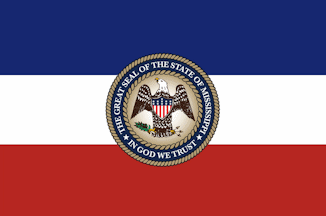 image by
Randy Young, 26 July 2020
image by
Randy Young, 26 July 2020
Last modified: 2025-01-04 by rick wyatt
Keywords: mississippi | united states | bonnie blue | magnolia |
Links: FOTW homepage |
search |
disclaimer and copyright |
write us |
mirrors
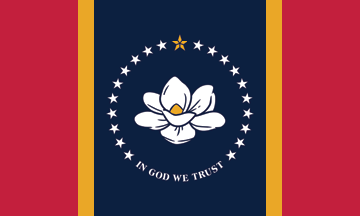 image by
Clay Moss, 15 November 2020
image by
Clay Moss, 15 November 2020See also:
In 1818, five stars were added, representing Indiana, Louisiana, Mississippi, Ohio and Tennessee, bringing the total number of stars on the U.S. flag to 20. There were thirteen stripes representing the thirteen original colonies.
The new flag for Mississippi was designed by Rocky Vaughan, with support provided by Sue Anna Joe, Kara Giles, and Dominique Pugh.
Description: The New Magnolia flag is anchored in the center field by a clean and modern magnolia blossom, a symbol long-used to represent the state and the hospitality of the citizens. The New Magnolia also represents Mississippi’s sense of hope and rebirth, as the Magnolia often blooms more than once and has a long blooming season. The New Magnolia is sleek and updated to represent the forward progression of Mississippi.
The circle of twenty stars represents Mississippi as the twentieth state of the United States of America and is anchored by the gold five-point star, which stands alone. This star represents our first peoples, the Indigenous Native American tribes of the land that would become Mississippi.
The color blue in the main field of the flag echoes the blue of the American flag, representing vigilance, justice, perseverance, while the bands of red represent hardiness and valor. The gold lines and the gold stamen of the New Magnolia are a nod to the rich cultural history of Mississippi, specifically the visual arts, literature, music, and performing arts to originate in our state.
Source:
https://www.mdah.ms.gov/flagpoll-top2
Tomislav Todorovic, 8 September 2020
The State of Mississippi on 30 June 2020 repealed the sections of the state code that established the state flag, essentially abolishing the state flag. The state legislature passed a bill on 28 June repealing the sections of the state code and it was signed into law by Governor Tate Reeves on 30 June. The law also stipulated that a replacement flag is to be designed by an appointed committee, to be confirmed by a statewide referendum in November, may not include any representations of Confederate flags and must include the words "In God We Trust." Effective 30 June 2020, the state of Mississippi officially has no flag.
 image by
Randy Young, 26 July 2020
image by
Randy Young, 26 July 2020
In the United States Capitol Building in Washington, DC, the former
Mississippi flag was removed from displays of state flags and replaced by a de
facto flag. (https://www.rollcall.com/ and
https://twitter.com/haleytalbotnbc). The de facto flag currently
representing Mississippi in the United States Capitol is a variation of the
Bicentennial flag. The flag is a horizontal
tricolor of blue-white-red, with the state seal centered and overlapping the
three stripes.
Randy Young, 26 July 2020
A gallery of publicly submitted flag designs for the new state flag is here:
https://mdah.pic-time.com/-flagcommission/gallery (requires identification)
Dave Fowler, 4 August 2020
A second round narrowed the selection to 147 possibilities:
https://mdah.pic-time.com/-flagcommissionround2/gallery (requires
identification)
Dave Fowler, 11 August 2020
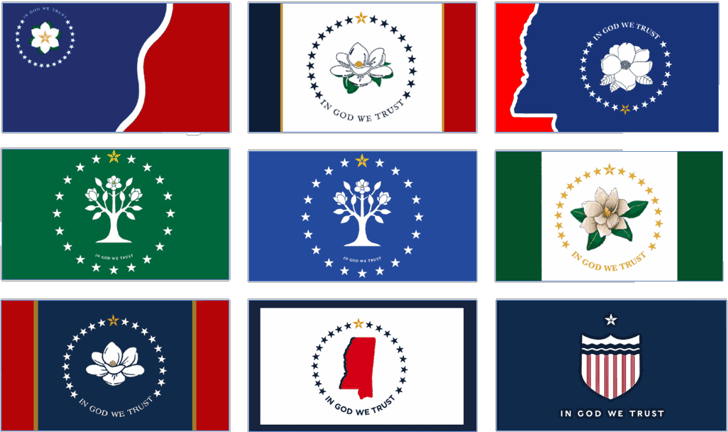 image
prepared by Pete Loeser, 15 August 2020
image
prepared by Pete Loeser, 15 August 2020
[click for larger image;
full image at
https://nava.org]
Further selection took the choice down to nine finalists:
https://www.clarionledger.com/story/news/politics/2020/08/14/mississippi-state-flag-commission-finalists-narrowed-nine/3374311001/
Dave Fowler, 15 August 2020
A group that will recommend a new [state] flag met Friday [Aug. 14] and
narrowed the field of proposed designs submitted by the public. Commissioners
intended to select the final five, but gave themselves a bit more time. They
chose nine designs, and each contains a star made of five diamond shapes. The
nine were posted on the [MS] state Department of Archives and History website
hours later, with a nonbinding survey for people to choose a favorite.
Commissioners will whittle the list to five designs on Tuesday [Aug. 18]. Seven
of the nine final designs are red, white and blue. Two are mostly green and
white.
Cyrus Ben, chief of the Mississippi Band of Choctaw Indians,
serves on the flag commission and said the diamond shape is frequently used in
Choctaw baskets and bead work. "The eastern diamondback rattlesnake is ... a
respected animal that also protected the crops in the fields," Ben said. "So,
that's where you see that diamond design."
From
https://abcnews.go.com/
William Garrison, 15 August 2020
The list was reduced again to
five:
https://mississippitoday.org/2020/08/18/one-of-these-five-designs-could-become-the-new-mississippi-state-flag,
then to two:
https://www.mdah.ms.gov/flagpoll-top2.
Tomislav Todorovic, 8 September 2020
The final two designs were the "Great River Flag" (top row, left, above) and
the "New Magnolia" (bottom row, left, above). Eventually, the winner was
announced on 2 September,
Tomislav Todorovic, 8 September 2020
Official Fimbriated Version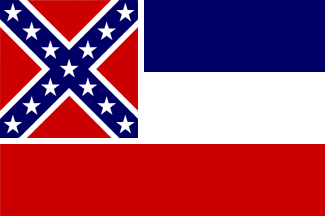 image by Clay Moss, 28 December 2005 |
Non-fimbriated Version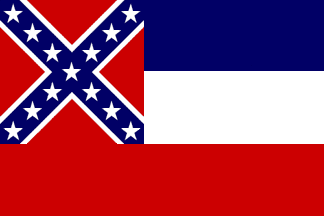 image by Clay Moss, 31 October 2007 |
"The Bonnie Blue flag of a white star on blue, was used as the state flag briefly. The Bonnie Blue type currently flown in Jackson at the Sillers Building, the state office building, is of a shade of blue like that of Somalia. The state then used a white flag which had a white star on a square canton of blue. The shade of blue varied greatly. Centered in the fly area was supposed to be a magnolia tree (Magnolia grandiflora) in natural color.
The red actually is quite problematic. The way that the description is written can lead to an interpretation of a red fringe, a red border, a red bar on the fly and other variations.
There is one 6' x 10' version that flies regularly with other historical flags at the Sillers Building. This "recognized" version has a dark blue canton (the same as the U.S. flag) with the single white star. The canton is square and two-thirds of the width of the flag (like the current Mississippi flag). It has a magnolia tree in the fly in natural color (normally green and white-no brown trunk). The dispute over the red and where it is to go has led to the decision to omit it altogether. Also, many of the known variations of this flag used in the American Civil War do not have any red in them. Many of those use blue and white only without the natural colored tree or with unit markings instead of the tree.
The same type of debate over the description of the Magnolia Tree Flag also afflicts the current flag. The description of the current flag, as submitted by the Joint Committee on state symbols, is:
'They recommended for the flag one with width two-thirds its length; with the union square, in width two-thirds of the width of the flag; the ground of the union to be red and a broad blue saltier [sic] thereon, bordered with white and emblazoned with thirteen (13) mullets of five-pointed stars corresponding with the number of the original States in the Union; the field to be divided into three bars of equal width, the upper one blue, the center one white and the lower one, extending the whole length of the flag, red--the national colors; the staff surmounted with a spear head and a battle-axe below; the flag to be fringed in gold and the staff gilded with gold.'Many problems arise because the description would allow for stars to be placed anywhere on the saltire (even all on one arm of the saltire) and still be valid as an official state flag. However, the greater debate is whether there should be a fimbriation or none. A fimbriation is not mentioned, but the clear implication of the drafters was to reinstall (or fondly remember) the Confederate flag. The current flag, regardless of its declared symbolism, is an attempt to combine the national flags of the Confederacy in a new way. In the past, it was quite common to see both fimbriated and non-fimbriated flags flying over the Mississippi capitol.
I have a copy of that letter [memo from Kirk Fordice] (and the occupying specifications), and am happy
to share it:
The letter is dated 17 July 1996, and "suggests" that the "specification enclosed" be followed. It goes on to say that "Any non-fimbriated flags will be acceptable until supplies are exhausted". The accompanying specification gives a canton of 23" square, bordered by a fimbriation of 1". The Saltire is given as 5" bordered by a fimbriation also 1" wide, with the stars upright ("as is the case with the US Flag") and 3.5" from point to point and 4" apart. All on a flag of 36" x 54". The specifications indicate that "the industry standard ratio" of 3:5 is officially acceptable.
Christopher Southworth, 28 July 2003
I prepared the specifications sheet in 1995 at the Governor's request. At the time, the spec sheet was not necessarily binding from an "official" standpoint. However, the Governor's letter (an executive order), sent to every US flag
manufacturer did begin the process of bringing more uniformity to Mississippi flags purchased by state government. After the flag referendum of 2001, the spec sheet was "officially" included in the description of Mississippi's flag.
Additionally, I put together a construction sheet specifying how larger Mississippi flags should be manufactured.
In a nutshell, all fully sewn Mississippi flags bought by the state must be entirely single thickness with the exception of the stars. No component of the canton can be manufactured using zigzag stitching. All parts must be joined using traditional hem and lock stitch techniques. If any part of a Mississippi flag is printed (ex. the canton), or if the flag is all printed, it must be acid dyed. Screen printed flags will not be accepted by the state. To date, most US flag manufacturers have not complied entirely with the spec sheet. For example, one company has been using left over parts from old 4x6 Georgia state flags (I think) and placing them in 6x10' Mississippi flags as cantons. The saltire is way too
narrow and the stars too small. However, they made up a big batch of them evidently, and they can be seen everywhere. Larger flags have been made correctly. The first time the state rejected a couple thousand dollars worth of wrongly made flags, it got everyone's attention. Since then, everything has been fairly uniform, and the state pretty much has the state flags it needs.
Clay Moss, 17 December 2007
So far as I can tell, the Mississippi code section 3-3-16 has not been amended since 2001 and still has the relatively "vague" description, though the source of this information appears to not have been updated with legislative
information for the 2005 through 2007 sessions:
C. 3-3-16. Design of state flag.
The official flag of the State of Mississippi shall have the following design: with width two-thirds (2/3) of its length; with the union (canton) to be square, in width two-thirds (2/3) of the width of the flag; the ground of the union to be red and a broad blue saltire thereon, bordered with white and emblazoned with thirteen (13) mullets or five-pointed stars,
corresponding with the number of the original States of the Union; the field to be divided into three (3) bars of equal width, the upper one blue, the center one white, and the lower one, extending the whole length of the flag, red (the
national colors); this being the flag adopted by the Mississippi Legislature in the 1894 Special Session.
SOURCES: Laws, 2001, ch. 301, Sec. 2, HB524, eff from and after February 7, 2001 (the date the United States Attorney General interposed no objection under Section 5 of the Voting Rights Act of 1965, to the addition of this section.).
See www.mscode.com/free/statutes/03/003/0016.htm
Some bills were introduced in 2004 that would have made changes to section 3-3-16, all of which died in committee:
HB 460 State flag; revise design to incorporate certain state Fleming emblems.
03/09 (H) Died In Committee
HB 461 State flag; reestablish flag design adopted by state Fleming convention of 1861 as official state flag.
03/09 (H) Died In Committee
HB 462 State flag; revise design of official state flag. Fleming 03/09 (H) Died In Committee
HB1339 Historical monuments and state flag; cannot be changed Chism without 2/3 vote of Legislature.
03/09 (H) Died In Committee
Same for 2003:
HB 349 State flag; revise design of official state flag. Fleming 02/04 (H) Died In Committee
HB 350 State flag; reestablish flag design adopted by state Fleming convention of 1861 as official state flag. 02/04 (H) Died In Committee
HB 361 Historical monuments and state flag; cannot be changed Chism without 2/3 vote of Legislature. 02/04 (H) Died In Committee
HB 821 State flag; revise design to incorporate certain state Fleming emblems. 02/04 (H) Died In Committee
And 2002:
HB 298 State flag; reestablish flag design adopted by state Fleming convention of 1861 as official state flag. 02/05 (H) Died In Committee
HB 299 State flag; revise design of official state flag. Fleming 02/05 (H) Died In Committee
HB1609 Historical monuments and state flag; cannot be changed Chism without 2/3 vote of the Legislature. 02/05 (H) Died In Committee
All of that information from billstatus.ls.state.ms.us/
Jon Radel, 24 December 2007
After all of the comments I have made on the subject of Mississippi's flag fimbriation, maybe the fimbriation isn't "official" after all. I have to confess that I have never actually read the legislation that would have made, (or made), the fimbriation official, or officiated my specification sheet for that matter. I have always taken it at face value that the fimbriation/specifications sheet was official by virtue of the fact that all involved parties in the whole flag
referendum legislature, the flag committee people, the Governor etc. told me right after the referendum that it was.
Clay Moss, 1 January 2008
I just came home from a road trip that included a week in Mississippi and can report that I saw not a single state flag flying anywhere in the state that lacked the fimbriation around the canton. The only non-fimbriated Mississippi flag I saw on the entire trip was in a display of all 50 state flags at the USS Alabama military and naval museum in Mobile, Alabama.
Joe McMillan, 1 August 2003
Mississippi adopted a 13 striped flag (6 white, 7 red) with a white star in the blue canton on Jan. 13, 1861.
William M. Grimes-Wyatt, 29 April 1996
The first flag to fly over an independent Mississippi in January of 1861, was a
blue flag with a single white star. This remained the unofficial state flag until an official one could be adopted.
Bart Mullis, 31 March 1998
When Mississippi's Ordinance of Secession was signed on 9 January 1861, it was marked by a ceremony in which the 'Bonnie Blue Flag' was raised over the capitol building in Jackson. Among those who witnessed the event was an Irish comedian named Harry Macarthy, who shortly after wrote and performed the famous song, 'The Bonnie Blue Flag'.
Filip Van Laenen, 31 March 1998
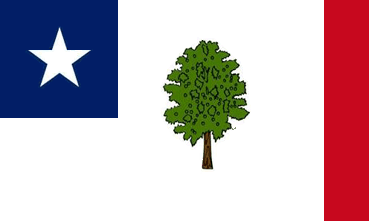 image by Clay Moss, 8 September 2014
image by Clay Moss, 8 September 2014
The flag of Mississippi during the War for Southern Independence (1861-1865) was a white flag with a magnolia tree in natural colors. The canton was blue and had a single white star (reminiscent of the Bonnie Blue flag). The fly was a thin red bar extending vertically the length of the flag; sometimes it included red fringe as well. The flag was so popular, it is the reason Mississippi became known as the "Magnolia State." This remained as the state flag until 1894 when the present flag was adopted. According to the designers, the thirteen stars in the St. Andrew's cross of the canton (the Confederate battle flag) represent the original thirteen colonies that made up the United States at its inception. The red, white and blue horizontal stripes represent the colors of the U.S.A.
Bart Mullis, 31 March 1998
Anyone who is a student of American Confederate vexillological history will recognize this image as Mississippi's secessionist flag, and later state flag. It is generally called the "Magnolia Flag". Having aggressively researched Mississippi's Magnolia flags over the past three years, I can now say with confidence that this particular version of the Magnolia flag never existed...at least not from 1861 to 1865. And, it was never the state flag.
As best as I can tell, this flag would become one of the Magnolia variants used by Mississippi chapters of the United Confederate Veterans from the late 1860's until the early to mid 20th Century. Somewhere along the way, someone apparently illustrated this flag in a "credible" publication, thus propelling it into that mythical world of actual flags.
Clay Moss, 8 September 2014
"I salute the flag of Mississippi and the sovereign state for which it stands with pride in her history and achievements and with confidence in her future under the guidance of Almighty God."
Phil Nelson, 13 August 1999
msmil.gif) image by Joe McMillan, 21 April 2000
image by Joe McMillan, 21 April 2000
The state military crest, which is the crest used in the coats of arms of units of the National Guard, as granted by the precursor organizations of what is now the Army Institute of Heraldry. The official Institute of Heraldry blazon is
"A slip of magnolia full flower with leaves proper behind a trident sable."
Joe McMillan, 21 April 2000